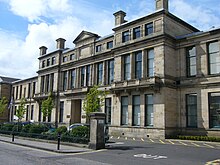Historic Scotland
 logo | |
| Successor | Historic Environment Scotland |
|---|---|
| Formation | 1991 |
| Dissolved | 2015 |
| Legal status | Executive Agency of the Scottish Government |
| Headquarters | Longmore House, Edinburgh |
Region served | Scotland |

Historic Scotland was based at Longmore House, Edinburgh
Historic Scotland (Scottish Gaelic: Alba Aosmhor) was an executive agency of the Scottish Government from 1991 to 2015, responsible for safeguarding Scotland's built heritage, and promoting its understanding and enjoyment. Under the terms of a Bill of the Scottish Parliament published on 3 March 2014, Historic Scotland was dissolved and its functions were transferred to Historic Environment Scotland (HES) on 1 October 2015. HES also took over the functions of the Royal Commission on the Ancient and Historical Monuments of Scotland.[1][2]
Contents
1 Role
2 Properties
3 Membership
4 See also
5 References
6 External links
Role
Historic Scotland was a successor organisation to the Ancient Monuments Division of the Ministry of Works and the Scottish Development Department. It was created as an agency in 1991 and was attached to the Scottish Executive Education Department, which embraces all aspects of the cultural heritage, in May 1999. As part of the Scottish Government, Historic Scotland was directly accountable to the Scottish Ministers.
In 2002, proposals to restore Castle Tioram in the West Highlands, by putting a roof back on, were blocked by Historic Scotland, which favoured stabilising it as a ruin. This position was supported in an extensive local Public Inquiry at which the arguments for both sides were heard.[3] It has been implied that this dispute has led to a review of the operations of the organisation.[4]
After widespread consultation, Historic Scotland published a comprehensive series of Scottish Historic Environment Policy papers, consolidated into a single volume in October 2008.[5]
The agency's Framework Document set out the responsibilities of the Scottish Ministers and the agency's Chief Executive.[6] Its Corporate Plan sets out its targets and performance against them.[7]
Historic Scotland and the Glasgow School of Art's Digital Design Studio formed the Centre for Digital Documentation and Visualization to promote the documentation and 3D representation of heritage objects, architecture and environments with laser scanning and 3D visualization software.[8]
Properties

Historic Scotland Ranger Service driving through Holyrood Park, Edinburgh
Historic Scotland had direct responsibility for maintaining and running over 360 monuments in its care, about a quarter of which are manned and charge admission entry. These properties have additional features such as guidebooks, books and other resources. Historic Scotland sought to increase the number of events run at its sites, most frequently designed to engage young people with history. Similarly, new museums and visitor centres were opened, notably at Arbroath Abbey and Urquhart Castle. There was also a hospitality section, which makes some properties available for wedding receptions and other functions.
Membership
Membership of Historic Scotland was promoted by the organisation, with benefits such as free entry to all their properties and over 400 events for the duration of the annual membership, as well as half price entry to properties in England (under the care of English Heritage), Wales (under the care of Cadw) and the Isle of Man (under the care of Manx National Heritage), becoming free in subsequent years. Lifetime memberships were also available, and all members received a quarterly magazine 'Historic Scotland'.
See also
- Royal Commission on the Ancient and Historical Monuments of Scotland
- Scottish Ten
References
^ "Historic Environment Scotland Bill". Scottish Parliament. Retrieved 6 July 2014..mw-parser-output cite.citationfont-style:inherit.mw-parser-output .citation qquotes:"""""""'""'".mw-parser-output .citation .cs1-lock-free abackground:url("//upload.wikimedia.org/wikipedia/commons/thumb/6/65/Lock-green.svg/9px-Lock-green.svg.png")no-repeat;background-position:right .1em center.mw-parser-output .citation .cs1-lock-limited a,.mw-parser-output .citation .cs1-lock-registration abackground:url("//upload.wikimedia.org/wikipedia/commons/thumb/d/d6/Lock-gray-alt-2.svg/9px-Lock-gray-alt-2.svg.png")no-repeat;background-position:right .1em center.mw-parser-output .citation .cs1-lock-subscription abackground:url("//upload.wikimedia.org/wikipedia/commons/thumb/a/aa/Lock-red-alt-2.svg/9px-Lock-red-alt-2.svg.png")no-repeat;background-position:right .1em center.mw-parser-output .cs1-subscription,.mw-parser-output .cs1-registrationcolor:#555.mw-parser-output .cs1-subscription span,.mw-parser-output .cs1-registration spanborder-bottom:1px dotted;cursor:help.mw-parser-output .cs1-ws-icon abackground:url("//upload.wikimedia.org/wikipedia/commons/thumb/4/4c/Wikisource-logo.svg/12px-Wikisource-logo.svg.png")no-repeat;background-position:right .1em center.mw-parser-output code.cs1-codecolor:inherit;background:inherit;border:inherit;padding:inherit.mw-parser-output .cs1-hidden-errordisplay:none;font-size:100%.mw-parser-output .cs1-visible-errorfont-size:100%.mw-parser-output .cs1-maintdisplay:none;color:#33aa33;margin-left:0.3em.mw-parser-output .cs1-subscription,.mw-parser-output .cs1-registration,.mw-parser-output .cs1-formatfont-size:95%.mw-parser-output .cs1-kern-left,.mw-parser-output .cs1-kern-wl-leftpadding-left:0.2em.mw-parser-output .cs1-kern-right,.mw-parser-output .cs1-kern-wl-rightpadding-right:0.2em
^ "About Historic Environment Scotland". Retrieved 15 November 2015.
^ "Inquiry Reports: Castle Tioram". Historic Scotland. Archived from the original on 27 January 2008. Retrieved 17 March 2013.
^ "Historic Scotland criticised over ruin". The Scotsman. 12 December 2002. Retrieved 17 March 2013.
^ "Scottish Historic Environment Policy". Historic Scotland. Retrieved 17 March 2013.
^ "Framework document 2012" (PDF). Historic Scotland. Retrieved 17 March 2013.
^ "Corporate plan" (PDF). Historic Scotland. Retrieved 17 March 2013.
^ "About the Scottish Ten". CDDV. Retrieved 17 March 2013.
External links
| Wikimedia Commons has media related to Historic Scotland. |
- Official website
